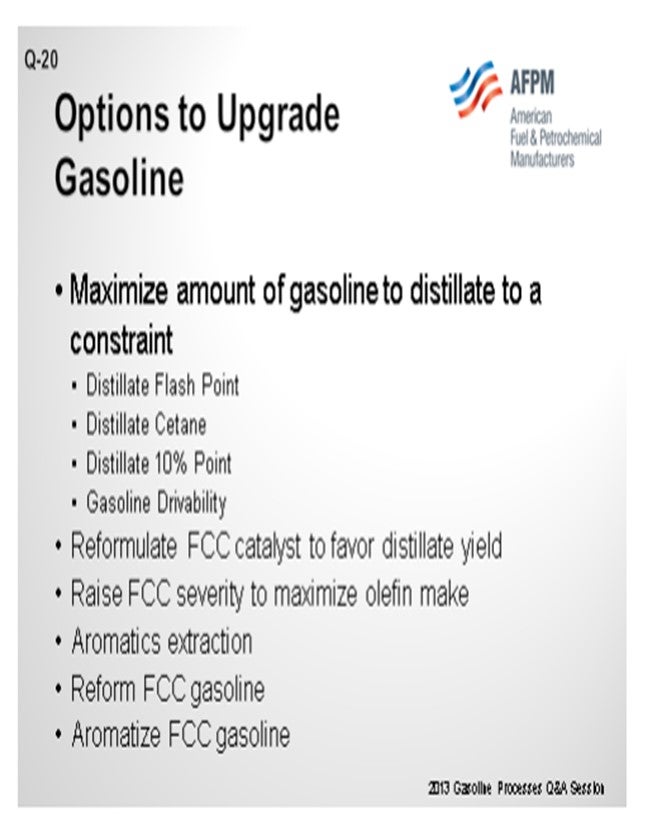Question 20: What investment, operational, or processing options are available to upgrade or convert gasoline streams to higher value products?
STREIT (KBC Advanced Technologies, Inc.)
First, there are not a lot of innovative solutions here on this list. For the most part, everyone is doing many of these things already. They are fairly straightforward. First, just maximize the amount of gasoline you are dropping in the distillate. The amount of gasoline that you can drop into distillate is usually constrained by the 10% point of the diesel, cetane, or flash point. It can also be constrained by the drivability index of the gasoline.
The next typical way of trying to upgrade gasoline is to reformulate the FCC catalyst to get more distillate selective yield off of the FCC and “unmake” the FCC gasoline in favor of distillate. Another path is actually to raise severity on the FCC and crack the gasoline into olefins. Obviously, depending on whether or not you have an outlet for those olefins will determine if that makes sense.
You can also do aromatics extraction. Generally, that is done on reformate, but it can be done on other streams. If you have an outlet for the aromatics, you can reduce your gasoline. Obviously, that will impact the octane on your gasoline, so you will have to make sure that it is in balance.
Finally, you can reform FCC gasoline by sending it to a reformer. There are a number of refiners who do that, at times. This step will convert some of that FCC gasoline into aromatics that you can recover as product.

ERIC STREIT (KBC Advanced Technologies, Inc.)
The first processing option, and one that most refiners are trying, is to make sure as much of the gasoline product as possible is shifted into distillate products through cutpoint adjustments. The maximum amount of naphtha that can be dropped into distillate is usually set by the jet or diesel product flashpoint or 10% point. Gasoline drivability or other specifications may also limit the amount of heavy gasoline material that can be shifted into distillate.
Because most of the gasoline in a U.S. refinery is usually made from the FCC, trying to reduce the FCC gasoline make is the next logical step. The first place to look for reducing FCC gasoline is usually catalyst formulation. Replacing catalyst with distillate selective catalyst, which is available from most catalyst suppliers, will help shift yields away from gasoline and toward distillate. Of course, this creates a new problem: what to do with the increased LCO production. Because LCO is a low-cetane blendstock, the amount that can be blended into diesel or diesel hydrotreater feed may be limited by the final product’s cetane specification. LCO is also a huge hydrogen consumer in a diesel hydrotreater, so it may be difficult to process in units that are not designed for high hydrogen makeup rates.
Raising FCC severity will shift gasoline yield toward light ends, increasing C3 and C4 olefins that can be sold as product or alkylated. This change in operations will also increase ethylene yield, which may be another product that can be recovered. While the olefin yield is increasing, so is the production of low-value saturated gases; so, any changes in FCC operation should take into account the downgrading of product into fuel gas, as well as the upgrading of product into olefins.
Aromatics extraction will reduce gasoline production. Most refiners who make aromatics extract the aromatics from reformate. However, heart-cut FCC naphtha can potentially be sent to an aromatic's extraction unit as well.
FCC gasoline can be reformed, as well. Refineries with an aromatic's outlet can hydrotreat the FCC gasoline to make reformer feed and then convert that material to aromatics. The lightest portion of the FCC gasoline does not make very good reformer feed and it is very high in olefin content so any refiner considering reforming FCC gasoline should look at splitting the material beforehand and only reforming the heavier portion.
Another process that is currently available is purported to convert the olefins in the FCC gasoline to aromatics. The byproducts of this process are LPG and fuel gas.